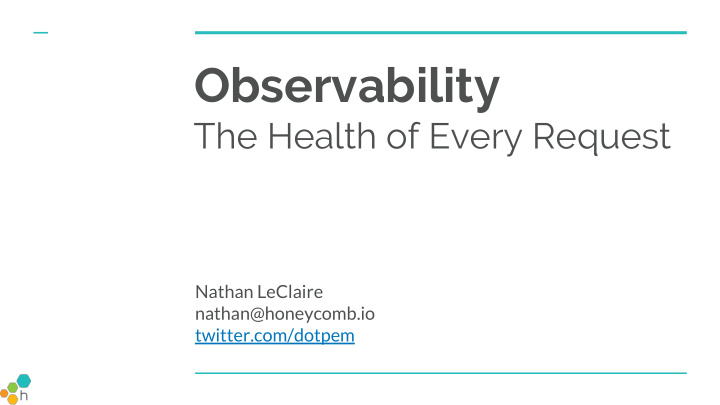



Observability The Health of Every Request Nathan LeClaire nathan@honeycomb.io twitter.com/dotpem
On Observability Where we have come from and why does o11y matter? o11y Report Card How do various approaches stack up? Overview The Health of Every Request Why should we care, and how do we care? Making o11y Affordable How do those of us with limited resources make it work?
$(whoami) Nathan LeClaire Previously Open Source Engineer at Docker. ● ● Platform Engineer and Sales Engineer at Honeycomb. Writer of “funny” tweets @dotpem and sometimes articles ● at https://nathanleclaire.com. Weapons of choice: Golang, Linux debugging tools, low ● bar squat, “Epic & Melodic” metal playlist on Spotify.
On Observability
What’s the big deal with o11y?
The world used to be simpler. Debugging is so easy. I just have one server I SSH into and I use tail on logs. BOOM!
But then VMs happened...
… then containers happened.
Now, #Serverless is happening?
But… our o11y tools are still bad and we should feel bad.
We have monitoring but we need observability vs.
Defining observability “Can I ask new questions about my system from the outside, and understand what is happening on the inside - all without shipping any new code?”
More observable businesses will build better platforms Seriously though, the winners of the future will be united by at least one common thread: they will offer more functionality and user customizability, up to and including executing arbitrary code. And more customizability comes with more o11y problems. Just look at Shopify, or Slack, or the recently released Github Actions feature. Why would Salesforce would buy Heroku? Because they are a platform company, not a CRM company.
More observable businesses will attract better engineers Company A: Company B: - Devs spend most of - Devs spend most of their time writing code their time firefighting - o11y gives them the - Deploys are an confidence to deploy infrequent occurrence frequently because they always - o11y makes it easy to cause new bugs understand how your - Engineers have very users are interacting few ways to with your code and understand what their how it’s performing code is doing once deployed
More observable businesses will beat their competitors
“Three Pillars?”
o11y report card
Metrics - D
Logs - C
Traces - B
Events in Columnar Store - A VENDOR DISCLAIMER
The Health of Every Request
How many requests do most apps get per user these days? A FUCKLOAD .
Everyone trashes averages, but P95 and P99 have started having dramatically less signal too. Many of your users, not just 1/100, will hit the 99th percentile of requests. We need to know context like: ● Which users or groups are seeing slowness or errors? ● Which database queries are executing slowly? ● Which hosts or containers did the problem requests pass through? ● What specifically is going wrong in malfunctioning background jobs?
Where we want to be o11y Nope. A deploy failed halfway through ● Are all the servers running the and now we have two versions. same version? Everything lower than 2.0.1, it must ● Which client versions are seeing have been a breaking change in our errors? API. ● Is just one user or group seeing It’s just one user, but they’re our issues, or is everyone? biggest customer. Do we need to upgrade our No one source of problems ● instances, or fix our code? contributing to high CPU can be identified. Buy bigger servers.
Making o11y Affordable
Facebook pioneered SCUBA, but most of us aren’t FAANG.
How to make o11y viable as scale increases? Sample.
BUT THIS WHOLE TALK IS ABOUT THE HEALTH OF EVERY REQUEST!
OK, OK. At scale you can’t store everything forever. But: 1. Statistics have your back. 2. Any problem worth worrying about will happen multiple times, or be big enough you can’t miss it. 3. Smart sampling keeps most of what you want, and less of the boring stuff. 4. In the future, we’ll likely be able to keep everything for a small duration, and sample out over time.
Example: Crank up sample rate on ingesting Elastic Load Balancer data to 50x retention.
https://research.fb.com/publications/canopy-end-to-end-performance-tracing-at-s cale/
https://people.mpi-sws.org/~jcmace/papers/lascasas2018weighted.pdf
Key Takeaways Observability gets you answers about the “why”, “how”, “what” ● of issues that monitoring cannot and can reduce issue resolution time from days to minutes. Sampling is a great way to make o11y affordable and scalable. ● Observability will be a key differentiator in successful ● businesses in the coming years.
I’m on Twitter - @dotpem Thanks for coming to my E-mail me: talk ! nathan@honeycomb.io Or come talk to me at our booth!
Recommend
More recommend